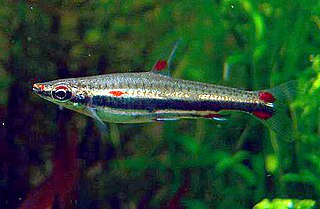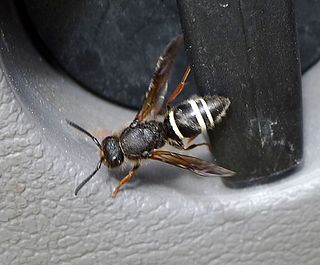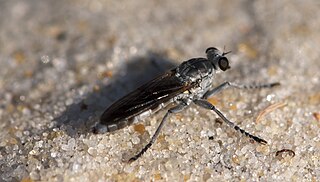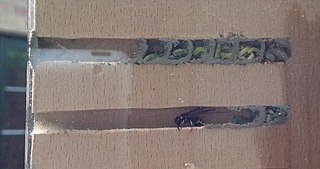
The three-banded rosefinch is a species of finch in the family Fringillidae.

The melon butterflyfish, or Indian redfin butterflyfish, is a species of marine ray-finned fish, a butterflyfish belonging to the family Chaetodontidae. It is found in the Indian Ocean from East Africa to Western Java. This is one species of a closely related group which includes the blacktail butterflyfish of the Red Sea and Gulf of Aden and the oval butterflyfish which is found in the western Pacific, from eastern coasts of the Indonesian islands to Australia.

The three-striped hemispingus is a species of bird in the family Thraupidae.

The Floreana mockingbird or the Charles Island mockingbird, is a species of bird in the family Mimidae.

Nannostomus trifasciatus,, commonly known as the three-lined or three-stripe pencilfish, is a freshwater species of fish belonging to the characin family Lebiasinidae. They are popular in the aquarium trade due to their small size, beautiful color pattern, and relative hardiness.

Ancistrocerus is a widely distributed genus of potter wasps present in many biogeographical regions of the world. They are nonpetiolate eumenine wasps with a transverse ridge at the bending summit of the first metasomal tergum and with a low and opaque propodeal lamella completely fused to the submarginal carina.

The European potter wasp or European tube wasp is a species of potter wasp. As an imago (adult), the female collects as many as 20 caterpillars for each nest, which consists of a single cell. Her larval offspring then feed on these inside the nest, which is sealed with mud arranged by her. As adults, they eat nectar and aphid honeydew. Males cannot sting, and the sting of a female is not painful. They can be found on windows, foraging for nectar on flowers, or searching out small cracks or holes in which to nest.

Astylus trifasciatus is a species of beetles native to Chile. Adult specimens are approximately 1.5 cm in length. They have orange-colored elytra with a black stripe down the center bisecting the insect and two black stripes trisecting the wing shells. They feed on flowering plants.
Maiestas trifasciatus is a species of bug from the Cicadellidae family that can be found on Canary Islands and countries including Iran and Burkina Faso. It was formerly placed within Recilia, but a 2009 revision moved it to Maiestas.

Astroblepus trifasciatus is a species of catfish of the family Astroblepidae. It can be found in Colombia.

Ancistrocerus scoticus is a Palearctic species of potter wasp.
Cerastipsocus trifasciatus is a species of common barklouse in the family Psocidae. It is found in Central America, North America, and South America.

Stichopogon trifasciatus, the three-banded robber fly, is a species of robber flies, insects in the family Asilidae.

Chrysis angustula is a species of cuckoo wasps, insects in the family Chrysididae.

Ancistrocerus longispinosus is a species of potter wasp, belonging to the family Vespidae, subfamily Eumeninae.

Ancistrocerus antilope is a species of wasp of the family Vespidae.
Ancistrocerus oviventris is a Palearctic species of potter wasp.

Ancistrocerus parietum is a species of insects belonging to the family Vespidae.















